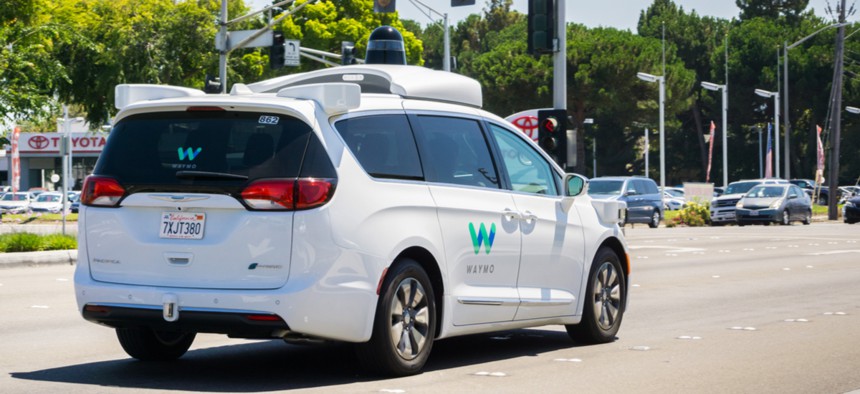Waymo Maintains Lead in Self-Driving Car Race

A Waymo self-driving vehicle in Mountain View, California Shutterstock
The California DMV just released hard numbers that confirm Google’s lead in the race to develop self-driving cars.
There is a lot of smoke, many mirrors, and a ton of investment dollars in self-driving cars right now. Everyone has a story to tell about their technology or data or approach. But the only hard numbers, required by regulation, come from the California Department of Motor Vehicles, which asks that any company driving autonomously report how many miles they’ve driven and how many times a human had to take over for the car’s AI.
Each year, Waymo, the self-driving car unit inside Alphabet, has been way out in front. The same was true again. In California, they drove 352,545 autonomous miles with 63 total disengagements, for a yearly average of 5,595 miles per disengagement. In the company’s best month, November 2017, they did 30,516 miles with a single disengagement. The only surprise in Waymo’s numbers is that their disengagement rate did not decline much from last year’s numbers. They also reported that they’ve been testing far more extensively, racking up 2 million total miles last year in 20 different cities.
One would expect that the vast majority of Waymo’s autonomous miles will come in Phoenix in 2018, where the company is launching a commercial pilot of its self-driving taxi service. Soon, however, Waymo will be expanding that trial to more cities. Chrysler recently reported that they are set to deliver “thousands” of the customized minivans that Waymo uses over the next year “to support Waymo as it expands its service to more cities across the United States.”
All this to say: Waymo’s been at it the longest and is certainly furthest along in developing a real autonomous service.
The only company that’s even in the same order of magnitude, in terms of miles driven in California, is Cruise, which was acquired by GM. They did 125,000 miles on San Francisco’s streets in self-driving mode and reported 105 total disengagements, for a yearly average of 1,254 miles per disengagement. In Cruise’s best month, October 2017, they drove 27,576 miles with only 3 disengagements.
These numbers show that Cruise has become become the clear-cut No. 2 for companies that are doing live testing in California. No one else is even close.

What about Tesla, you ask? Well, their filing to the regulatory body notes, almost as an aside, that they drove 0 autonomous miles in the state of California. Their letter to the DMV primarily makes the argument for the value of their singular approach.
Because Tesla has a big fleet, the company is gathering data from each of those cars. Although this data is much thinner than what Waymo or Cruise get with their more expensive sensor arrays, they are piling up a ton of miles. “Tesla is able to use billions of miles of real-world driving data to develop its autonomous technology,” wrote Tesla’s associate general counsel, Al Prescott. “In ‘shadow mode,’ features run in the background without actuating vehicle controls in order to provide data on how the features would perform in real-world and real-time conditions.”
Furthermore, Prescott concluded, “We are able to develop our self-driving system more efficiently than only by accumulating data from a limited number of autonomous vehicles tested in limited locations.”
This may all be true, but we would just have to take Tesla’s word for it, while these other companies are showing what they can do in live conditions, and subject to regulatory oversight. For now, there is not enough evidence in the actual record to judge where Tesla’s efforts should rank.
Many of the big car companies who were licensed to test autonomous vehicles did not actually do so, or barely dipped a toe in the water. BMW, Ford, Honda, and Volkswagen did not test their cars in autonomous mode in California for a single mile on public roads. Mercedes-Benz logged 1,087 miles. Other than GM, only Nissan logged more than 5,000 miles among the big car companies, and they did 5,007, although with a top-three disengagement rate.
Two well-funded start-ups put up interesting performances. Zoox, which has taken $290 million in venture funding, was able to go 430 miles per disengagement in the final month of the reporting period, November 2017, though they only had 2,244 miles for the whole year. Drive.ai, which has taken $77 million in VC, did 6,572 total autonomous miles with 151 disengagements, for a respectable average of 43 for the year. November 2017 was their best month, too, when they managed 2,642 autonomous miles with only 24 disengagements for an average of 110 miles per problem.
Overall, the new numbers feel a little disappointing. We’re not seeing a spike in the number of companies that are able to execute well on California roads, nor are we seeing an explosion in the number of miles driven or massive reductions in disengagements per mile. It could be that this is happening in other states, outside the regulatory reporting spotlight. But for now, this looks like a two-car race with a Tesla revving its engine in the infield.
Alexis Madrigal is a staff writer at The Atlantic, where this article was originally published.
NEXT STORY: Could Puerto Rico Turn Out to Be Trump’s First Infrastructure Win?






